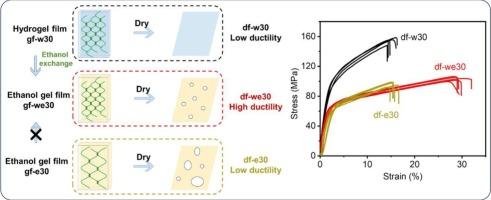Regulating supramolecular structure to enhance the ductility of regenerated cellulose films from ionic liquid solution
IF 12.5
1区 化学
Q1 CHEMISTRY, APPLIED
引用次数: 0
Abstract
Regenerated cellulose films suffer from inherent brittleness, restricting their practical use. Conventional plasticizer-based strategies can enhance ductility; however, plasticizer migration is an issue. Regulating supramolecular structure during processing is an alternative. We investigated the influence of coagulation bath temperature and coagulant types on the microstructure and mechanical properties of regenerated cellulose films using 1-allyl-3-methylimidazolium chloride (AmimCl) ionic liquid. The regeneration bath at 30 °C yielded hydrogels with a fine, dense, uniform network compared to those at 60 °C or 90 °C. Simple drying of the uniform network resulted in films with increased elongation at break (~15 %) while maintaining high tensile strength (~150 MPa). Solvent exchange to ethanol prior to drying preserved the hydrogel network, yielding dry films with elongation at break up to 30 % and a tensile strength above 100 MPa. This property of film is related to the nanoscale structural heterogeneity: (1) a fine, dense and uniform network formed in the hydrogel; (2) lower density and hence looser packing due to the lower surface tension of ethanol. Thus, controlling coagulation conditions can effectively tailor nanoscale structural heterogeneity to significantly enhance ductility.

调节超分子结构以提高离子液体再生纤维素膜的延展性
再生纤维素薄膜具有固有的脆性,限制了其实际应用。传统的增塑剂策略可以提高延展性;然而,增塑剂迁移是一个问题。在加工过程中调节超分子结构是一种选择。研究了混凝浴温度和混凝剂类型对1-烯丙基-3-甲基咪唑氯离子液体再生纤维素膜微观结构和力学性能的影响。与60°C或90°C的再生浴相比,30°C的再生浴产生的水凝胶具有精细、致密、均匀的网络。通过对均匀网络进行简单的干燥处理,薄膜的断裂伸长率提高了~ 15%,同时保持了较高的抗拉强度(~ 150mpa)。干燥前将溶剂交换到乙醇,保留了水凝胶网络,产生了断裂伸长率高达30%,抗拉强度超过100mpa的干膜。膜的这种特性与纳米尺度结构的非均质性有关:(1)水凝胶内部形成了精细、致密、均匀的网状结构;(2)由于乙醇的表面张力较低,密度较低,因此包装较松散。因此,控制混凝条件可以有效地调整纳米级结构的非均质性,从而显著提高延性。
本文章由计算机程序翻译,如有差异,请以英文原文为准。
求助全文
约1分钟内获得全文
求助全文
来源期刊

Carbohydrate Polymers
化学-高分子科学
CiteScore
22.40
自引率
8.00%
发文量
1286
审稿时长
47 days
期刊介绍:
Carbohydrate Polymers stands as a prominent journal in the glycoscience field, dedicated to exploring and harnessing the potential of polysaccharides with applications spanning bioenergy, bioplastics, biomaterials, biorefining, chemistry, drug delivery, food, health, nanotechnology, packaging, paper, pharmaceuticals, medicine, oil recovery, textiles, tissue engineering, wood, and various aspects of glycoscience.
The journal emphasizes the central role of well-characterized carbohydrate polymers, highlighting their significance as the primary focus rather than a peripheral topic. Each paper must prominently feature at least one named carbohydrate polymer, evident in both citation and title, with a commitment to innovative research that advances scientific knowledge.
 求助内容:
求助内容: 应助结果提醒方式:
应助结果提醒方式:


